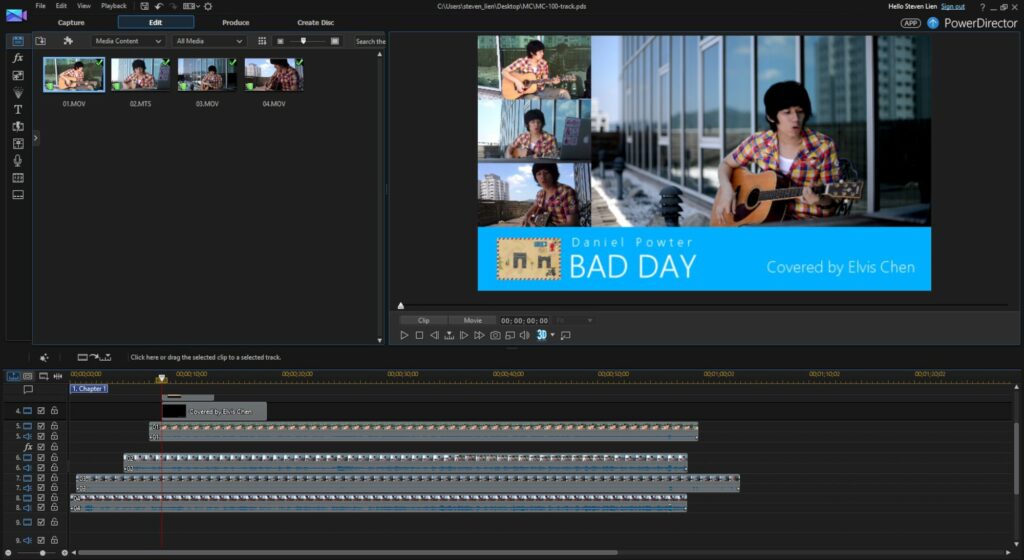How to use the multi-cam editing feature in PowerDirector

Creating multi-cam edits in PowerDirector allows you to synchronize and switch between multiple camera angles or video sources, ideal for capturing live events, interviews, performances, or any scenario recorded from multiple perspectives. PowerDirector’s multi-cam editing feature streamlines the process of aligning and blending footage from different cameras or sources into a cohesive and dynamic final video. This comprehensive guide will walk you through everything you need to know about using the multi-cam editing feature in PowerDirector, covering setup, synchronization, switching angles, fine-tuning, creative applications, troubleshooting tips, and more.
Understanding Multi-Cam Editing in PowerDirector
Multi-cam editing in PowerDirector involves combining footage from multiple cameras or sources into a single timeline, allowing you to seamlessly switch between angles or views during playback. Key aspects of multi-cam editing include:
- Synchronization: Aligning audio and video tracks from different sources to ensure seamless switching.
- Angle Switching: Real-time or post-production switching between camera angles for dynamic visual storytelling.
- Timeline Management: Organizing and editing multi-cam footage within the timeline for efficient workflow and precision.
Mastering multi-cam editing in PowerDirector empowers you to create engaging videos with professional polish, capturing the action from various perspectives and enhancing viewer immersion.
Getting Started with Multi-Cam Editing in PowerDirector
Preparing for Multi-Cam Editing
- Importing Media: Import video clips from multiple cameras or sources into the Media Room.
- Organizing Footage: Arrange imported clips into folders or categories for easy access and management within the Media Room.
Setting Up Multi-Cam Editing
- Creating a Project: Launch PowerDirector and create a new project or open an existing one to begin multi-cam editing.
- Timeline Setup: Create a timeline suitable for multi-cam editing by ensuring sufficient space and layout flexibility for multiple video tracks.
Basic Multi-Cam Editing Techniques
Synchronizing Footage
- Auto-Sync Feature: Use PowerDirector’s auto-sync feature to automatically align audio and video tracks from different cameras based on common cues (e.g., claps, markers).
- Manual Sync: Manually adjust audio and video synchronization if needed by aligning waveforms or visual cues between camera angles.
Multi-Cam View Setup
- Multi-Cam View Mode: Enter multi-cam view mode to preview and select camera angles for editing and switching within the timeline.
- Preview Window: Use the preview window to monitor and switch between synchronized camera angles during playback.
Angle Switching
- Real-Time Switching: Switch between camera angles in real-time during playback to capture live events or performances.
- Post-Production Editing: Edit and refine angle switches within the timeline for precise timing and visual impact.
Fine-Tuning Multi-Cam Edits
Cut and Trim
- Cutting Clips: Use cutting and trimming tools to remove unwanted segments or refine transitions between camera angles.
- Timeline Adjustments: Make adjustments to clip durations, overlaps, or transitions to enhance visual flow and storytelling.
Effects and Enhancements
- Visual Effects: Apply effects, filters, or color corrections to individual camera angles to achieve desired visual aesthetics.
- Audio Adjustments: Adjust audio levels, apply filters, or mix audio tracks from different sources for balanced and clear sound throughout the multi-cam edit.
Creative Applications of Multi-Cam Editing
Live Events and Performances
- Live Streaming: Use multi-cam editing for live streaming events, concerts, or performances to capture dynamic moments from multiple angles.
- Sports Coverage: Create compelling sports highlights or coverage by switching between different camera perspectives to capture key moments and actions.
Interviews and Documentaries
- Interviews: Record and edit interviews using multi-cam editing to switch between interviewer and interviewee perspectives for engaging storytelling.
- Documentaries: Produce documentaries with varied viewpoints or scenes by seamlessly blending footage from multiple cameras or sources.
Educational and Tutorial Videos
- Educational Content: Create instructional or tutorial videos with multi-cam editing to showcase demonstrations, experiments, or step-by-step processes.
- Visual Demonstrations: Enhance educational content by switching between close-up, wide-angle, or overhead views to illustrate concepts effectively.
Tips for Effective Multi-Cam Editing
Pre-Production Planning
- Camera Setup: Plan camera positions, angles, and settings before recording to ensure consistency and compatibility for multi-cam editing.
- Storyboarding: Create a storyboard or shot list to outline camera angles, sequences, and transitions for efficient editing and storytelling.
Workflow Efficiency
- Keyboard Shortcuts: Familiarize yourself with PowerDirector’s keyboard shortcuts for quick access to editing tools and timeline navigation.
- Batch Processing: Utilize batch processing features to apply consistent edits, effects, or adjustments across multiple camera angles or clips.
Audience Engagement
- Dynamic Switching: Use dynamic angle switching and transitions to maintain viewer engagement and enhance narrative flow throughout the video.
- Feedback Review: Gather feedback from colleagues, peers, or viewers to refine multi-cam edits and ensure clarity, impact, and visual coherence.
Troubleshooting Multi-Cam Editing Issues
Synchronization and Timing
- Sync Adjustments: Fine-tune audio and video synchronization between camera angles to minimize delays or discrepancies in multi-cam edits.
- Frame Rate Compatibility: Ensure frame rate consistency across all camera sources to prevent playback issues or visual discrepancies during angle switching.
Visual and Audio Quality
- Quality Check: Review multi-cam edits for visual artifacts, audio sync issues, or playback concerns before finalizing and exporting.
- Render Settings: Adjust render settings and export configurations to optimize video quality and compatibility for different devices or platforms.
Playback and Export Considerations
- Device Compatibility: Test multi-cam edits on various devices and playback platforms to ensure seamless playback and visual fidelity.
- Export Formats: Choose appropriate export formats and settings to maintain video quality and ensure compatibility with intended viewing platforms.
Conclusion
Mastering multi-cam editing in PowerDirector empowers you to create dynamic and immersive video content by seamlessly blending footage from multiple cameras or sources. By following the tools, techniques, and creative applications outlined in this guide, you can effectively utilize PowerDirector’s versatile multi-cam editing features to synchronize, switch, and fine-tune camera angles for compelling storytelling, engaging presentations, or live event coverage. Whether for live performances, interviews, documentaries, educational content, or creative projects, PowerDirector enables you to capture diverse perspectives, enhance viewer engagement, and produce professional-quality videos that captivate, inform, and inspire audiences. Experiment with different camera angles, transitions, effects, and audio integration options, leverage advanced editing capabilities, and explore the versatility of multi-cam editing in PowerDirector to elevate your video production and achieve impactful visual storytelling.




